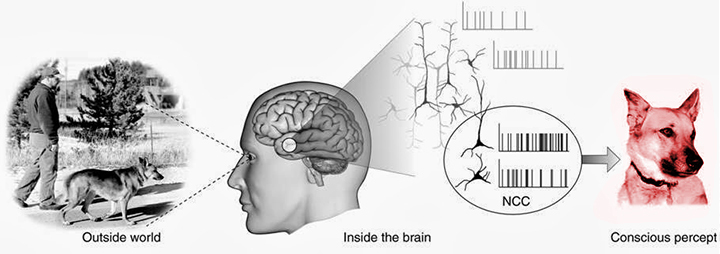In The Big Picture, Sean Carroll is anxious to reject religious ideas of the immortal soul, and this makes him equally anxious to reject any sort of dualism. As a consequence, he ends up endorsing behaviorism as his philosophy of mind, though perhaps covertly. The word “behaviorism” does not occur in The Big Picture. His discussion of color reveals his ambivalence, since color poses a significant challenge for behaviorism. Simon Blackburn: “Philosophically the doctrine of behaviourism is that mental states are logical constructions out of dispositions to behaviour, or in other words, that describing the mental aspects of a person is a shorthand for describing the various dispositions to behaviour that the person possesses. The most influential work promoting this point of view was The Concept of Mind (1949) by Gilbert Ryle which urged behaviourism as the best defence against the Cartesian myth of the ‘ghost in the machine’.”
Carroll starts by discussing how in 1642, Princess Elisabeth of Bohemia famously questioned Descartes on how the material body could interact with an immaterial mind. Her question was better than Descartes’ answer. No satisfactory answer is available even today. In The Big Picture, Sean Carroll suggests that therefore dualism cannot be true:
she was most distinguished by her freedom of thought and questioning intellect, which led her to challenge one of Descartes’s most famous positions: mind-body dualism, the idea that the mind or soul is an immaterial substance distinct from the body. If that were true, she insisted on knowing, how did the two substances communicate with each other?
These days we would say it this way: our bodies are made of atoms, which are in turn made of particles, and those particles obey the equations of the Core Theory. If you want to say that the mind is a separate substance, not just a way of talking about the collective effect of all those particles, how does that substance interact with the particles? How are the equations of the Core Theory incorrect, and how should we improve them? p. 205
To a poetic naturalist, “mind” is simply a way of talking about the behavior of certain collections of physical matter, just as “heaviness” is. The problem is that Descartes is nobody’s naturalist. p. 210
Modern science knows a lot more about the behavior of matter than seventeenth-century science did. The Core Theory of contemporary physics describes the atoms and forces that constitute our brains and bodies in exquisite detail, in terms of a rigid and unforgiving set of formal equations that leaves no wiggle room for intervention by nonmaterial influence, The way we talk about immaterial souls, meanwhile, has not risen to that level of sophistication. To imagine that the soul pushes around the electron and protons and neutrons in our bodies in a way that we haven’t yet detected is certainly conceivable, but it implies that modern physics is profoundly wrong in a way that has so far eluded every controlled experiment ever performed. How should we modify the Core Theory equation to allow for the soul to influence the particles in our body? It’s a substantial hurdle to leap. p. 212
Immortal souls cannot be part of the physical world and therefore cannot be real. For Sean Carroll, “mind” is simply a way of talking about behavior, an idea he mentions in connection with Gilbert Ryle.
For a working neuroscientist like Christof Koch, however, consciousness is not simply a way of talking about behavior. Consciousness is something real: induced by or produced by or caused by the brain.
Consciousness is a puzzling, state-dependent property of certain types of complex, biological, adaptive, and highly interconnected systems. A science of consciousness must strive to explain the exact relationship between phenomenal mental states and brain states. This is the heart of the classical mind-body problem: What is the nature of the relationship between the immaterial, conscious mind and its physical basis in the electrochemical interactions in the body? Brain scientists are exploiting a number of empirical approaches to shed light on the neural basis of consciousness.
Progress in addressing the mind-body problem has come from focusing on empirically accessible questions rather than on eristic philosophical arguments. Key is the search for the neuronal correlates — and ultimately the causes — of consciousness. http://www.scholarpedia.org/article/Neural_correlates_of_consciousness 2007 Koch and Mormann

In Koch’s diagram, causation moves left to right. Light reflected off objects in the Outside World contains useful information. Your eyes transduce that information into neural impulses. “The arrival of photons on the retina is transduced thanks to rhodopsin in the rods and cones, to yield spike trains in the optic nerve.” (Dan Dennett) The spike trains travel to the brain for processing of the information. The bar codes in the diagram represent the information, here shown at a level of abstraction. Some neural processes have the capacity to cause the Conscious Percept—those are the NCCs. The arrow on the right shows this physical to nonphysical causation. You have a conscious visual experience of the dog. There are two transductions in Koch’s schema. The first changes the information in light into neural impulses. The second transduction is represented by the arrow on the right of the diagram, showing NCCs are transduced into images in the immaterial conscious mind. The conscious percept does not exist independently of the NCCs, so nothing here creates an immortal soul.
The science of color supports Koch’s schema. Light reflected from objects arrives at the eye in various wavelengths. The brain decodes the wavelength information as color. The important point is that neither the objects in the physical world nor the light reflected from them is colored. The only thing colored is the immaterial conscious percept. Only the dog on the right is colored. Steve Palmer: “Neither objects nor lights are actually ‘colored’ in anything like the way we experience them. Rather, color is a psychological property of our visual experiences when we look at objects and lights, not a physical property of those objects or lights.” Vison Science p. 95 For more, see BQTA post The Science of Color.
Color is not a part of the physical world. Light contains wavelength but not color. Wavelength is not color. Carroll struggles to appreciate the point fully.
Consider the color red. It is a useful concept, one that can apparently be recognized universally and objectively, at least by sighted people who are not prevented from seeing red by color blindness… The world qualia is sometimes used to denote the subjective experience of the way something seems to us. “Red” is a color, a physically objective wavelength of light or appropriate combination thereof; but “the experience of the redness of red” is one of the qualia we would like to account for in a complete understanding of consciousness. p 349-350.
Red is neither simply a useful concept nor is it a physically objective wavelength of light. It’s a psychological property of our conscious percepts. Unclear whether Carroll thinks the concept “qualia” is simply a way of talking or something real science needs to account for.
According to poetic naturalism… “consciousness” is a particular way of talking about the behavior of certain physical systems. The phrase “experiencing the redness of red” is part of a higher-level vocabulary we use to talk about the emergent behavior of the underlying physical system, not something separate from the physical system. That doesn’t mean it’s not real; my experience of redness is perfectly real, as is yours. It’s real in exactly the same way as fluids and chairs and universities and legal codes are real—in the sense that they play an essential role in a successful description of a certain part of the natural world, within a certain domain of applicability. p. 358
Colors and legal codes are real in exactly the same way? What way is that? “They play an essential role in a successful description of a certain part of the natural world.” So a kind of useful fiction? Legal codes and universities are social facts, not physical facts. Fluids and chairs, however, are not social constructs; they are medium sized physical objects, like dogs and brains. These are all perfectly respectable residents of the physical world. But color is not. “Color is not a physical property of those objects or lights.” (Palmer)
Carroll is best interpreted to be endorsing a full-blooded behaviorism.
Consciousness is just a concept we use to describe certain useful behaviours… The idea that our mental experiences or qualia are not actually separate things, but instead are useful parts of certain stories we tell about ordinary physical things, is one that many people find hard to swallow. p. 359
Our mental experiences are simply useful parts of certain stories we tell? Count me among the many people who have a hard time swallowing that. Think of a mental experience like pain. Merely part of a useful story? Merely behavior? You can have pain without pain behavior, or pain behavior without pain. Therefore, mental experiences like pain are “actually separate things.” What kind of things mental experiences are remains to be determined. Carroll seems confused about what the NCCs are correlated with:
What I’m suggesting is that the statement “I have a feeling . . .” is part of an emergent way of talking about those signals appearing in your brain. There is one way of talking that speaks in a vocabulary of neurons and synapses and so forth, and another way that speaks of people and their experiences. And there is a map between these ways: when the neurons do a certain thing, the person feels a certain way. And that’s all there is. p. 359
So the correlation is between “one way of talking” and another? That’s not the way cognitive scientists like Christof Koch and Steve Palmer look at their work. They think they are correlating real brain states with real mental states, reported by statements like “I have a feeling…” The “map” Carroll refers to seems to be between ways of talking.
Share this:





